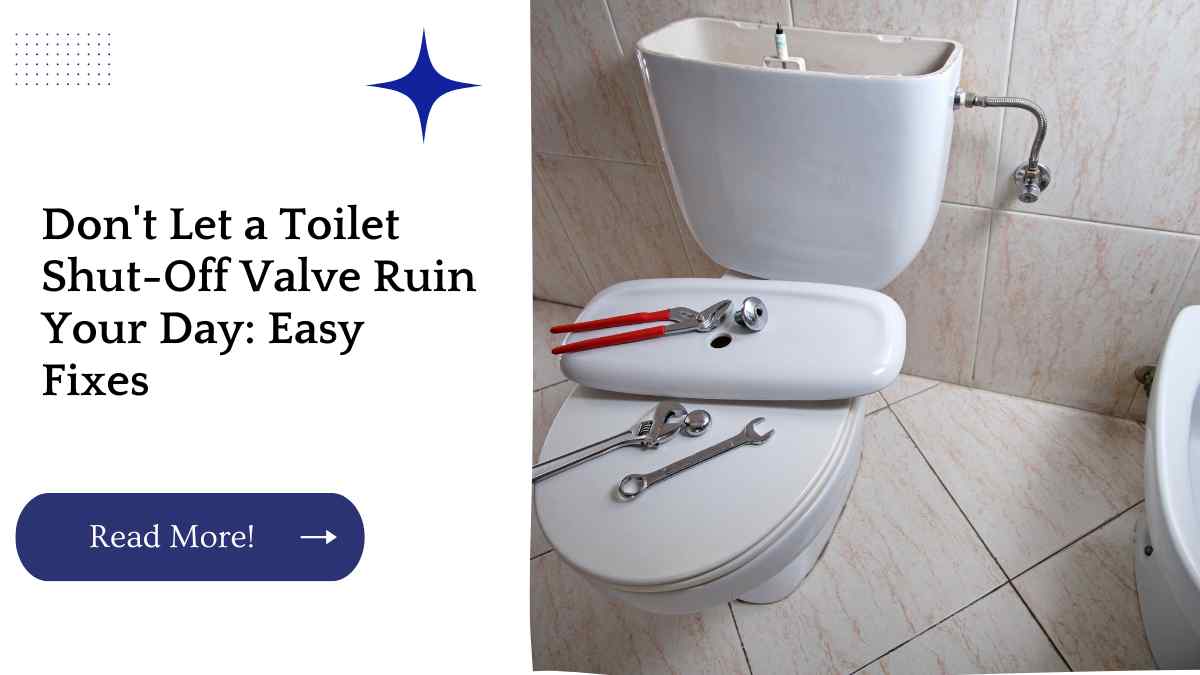A faulty toilet shut-off valve can be a frustrating and inconvenient problem. Not only does it prevent you from being able to use your toilet properly, but it can also lead to higher water bills and potential water damage.
| Key Takeaways |
|---|
| Understanding what a toilet shut-off valve is and its purpose. |
| Identifying signs of a faulty shut-off valve. |
| Knowing common reasons for a faulty shut-off valve. |
| Learning how to fix a faulty shut-off valve. |
| Taking steps to prevent future issues with shut-off valves. |
In this article, we will provide easy fixes for a toilet shut-off valve that’s causing issues.
What is a Toilet Shut-Off Valve?
A toilet shut-off valve is a valve that controls the flow of water into your toilet. It’s typically located behind or near the toilet and is used to turn off the water supply in case of a leak or other plumbing issue.
Signs of a Faulty Shut-Off Valve
There are a few signs that indicate your shut-off valve may be faulty. These include:
- Difficulty turning the valve
- Water leaking from the valve
- The valve not shutting off the water supply completely
Knowing how to effectively use your shower shut-off valves might save you from costly repairs and prevent water damage in your home. Check out our guide on learning how to use your shower shut-off valves for some tips and tricks!
Reasons for a Faulty Shut-Off Valve
There are several reasons why a shut-off valve may become faulty, including:
- Wear and tear over time
- Mineral buildup
- Corrosion
- Damage to the valve
How to Fix a Faulty Shut-Off Valve
There are a few easy fixes for a faulty shut-off valve. Before attempting any of these fixes, it’s important to shut off the water supply to your toilet.
1. Shutting off the Water Supply
To shut off the water supply to your toilet, locate the shut-off valve and turn it clockwise until it’s fully closed. This will prevent water from flowing into your toilet and allow you to work on the shut-off valve.
If you’re installing a dishwasher and don’t have a sink, it may seem like a difficult task to connect the plumbing. However, with our DIY tips for plumbing a dishwasher without a sink, you can have your dishwasher up and running in no time!
2. Replacing the Washers
If the shut-off valve is leaking, it may be due to a faulty washer. To replace the washer, remove the handle and unscrew the packing nut. Remove the old washer and replace it with a new one. Reassemble the valve and turn the water supply back on to test it.
3. Tightening the Packing Nut
If the shut-off valve is leaking from around the handle, it may be due to a loose packing nut. To tighten the packing nut, use a wrench to turn it clockwise until it’s snug.
A rusty toilet flange is a common issue homeowners face, but fixing it can be a DIY task. Learn how to replace your rusty toilet flange in our step-by-step guide and save hundreds of dollars on a plumber!
4. Replacing the Shut-Off Valve
If the shut-off valve is damaged or corroded, it may need to be replaced. To replace the valve, shut off the water supply and remove the old valve. Install the new valve and turn the water supply back on to test it.
5. Hiring a Professional Plumber
If you’re not comfortable working with plumbing fixtures, or if the shut-off valve is particularly difficult to fix, it’s best to hire a professional plumber. A plumber can quickly diagnose the issue and provide a solution that will ensure the valve is functioning properly.
Preventing Future Issues with Shut-Off Valves
To prevent future issues with shut-off valves, there are a few steps you can take. First, be sure to turn the valve on and off periodically to keep it from becoming stuck.
Additionally, avoid using excessive force when turning the valve, as this can cause damage over time. Finally, consider having your shut-off valves inspected and replaced periodically by a professional plumber to ensure they’re in good working order.
Having a toilet that’s level may seem like a minor detail, but it can impact the function and longevity of your toilet. Check out our guide on the benefits of a level toilet and how to achieve it to ensure your toilet is functioning correctly!
Further Reading
Here are some additional resources to help you learn more about toilet shut-off valves:
Shutting Off Toilet Water Supply: This article provides step-by-step instructions for shutting off the water supply to your toilet.
How to Turn Off the Water Supply to a Toilet: This wikiHow article provides detailed instructions for turning off the water supply to a toilet, including both traditional and emergency shut-off methods.
Prevent Water Damage While You Are Away: This article provides tips for preventing water damage in your home while you’re away, including shutting off the water supply to your toilets.
Conclusion
A faulty shut-off valve can cause a lot of frustration, but fortunately, there are easy fixes that can be done at home. Whether you need to replace a washer, tighten a packing nut, or even replace the entire valve, these fixes can be done quickly and easily.
following these tips, you can ensure your shut-off valve is working properly and avoid future plumbing issues.
A leaking kitchen sink drain can cause water damage in your home and be a frustrating issue to deal with. With our DIY solutions for fixing a leaking kitchen sink drain, you can save time and money by fixing the issue yourself!
FAQs
What causes a shut-off valve to become faulty?
There are several reasons why a shut-off valve may become faulty, including wear and tear over time, mineral buildup, corrosion, and damage to the valve.
How do I know if my shut-off valve is faulty?
Some signs of a faulty shut-off valve include difficulty turning the valve, water leaking from the valve, and the valve not shutting off the water supply completely.
Can I fix a faulty shut-off valve myself?
If you’re comfortable working with plumbing fixtures, there are several easy fixes for a faulty shut-off valve that you can do yourself. However, if you’re not comfortable, it’s best to hire a professional plumber.
How can I prevent future issues with shut-off valves?
To prevent future issues with shut-off valves, turn the valve on and off periodically, avoid using excessive force when turning the valve, and consider having your shut-off valves inspected and replaced periodically by a professional plumber.
How much does it cost to replace a shut-off valve?
The cost to replace a shut-off valve can vary depending on the location of the valve and the complexity of the job. It’s best to get a quote from a professional plumber to determine the exact cost

Hellen James is the author of the blog and a licensed plumber with over 15 years of experience. She shares her knowledge and experience in plumbing and drainage through insightful and informative articles

